There's nothing quite like fresh pasta, and this homemade gluten free pasta is no exception! With just a few simple ingredients, I'll show you how easy it is to make.
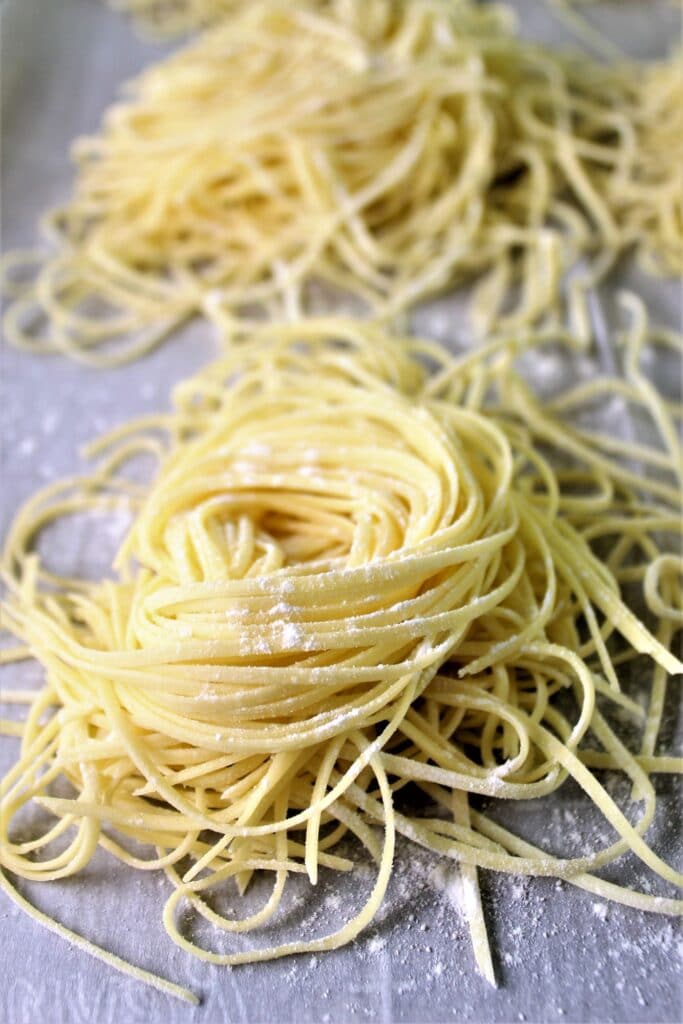
There are several great gluten free pasta varieties on the market these days, and I'm not knocking 'em. I'm SO, SO glad that we actually have options in the grocery stores for staples such as pasta.
Even as there are several great non-gluten free pastas out there, people often make homemade pasta because it's 1) fresh, 2) fun to make, and 3) delicious!
What I love about homemade gluten free pasta is that it doesn't fall apart like store bought gf pasta often can. Especially if you want to make a pasta dish that's cold, such as a pasta salad, or even one that often gets reheated in my house (my favorite pasta ever--simple broccoli pasta).
The Ingredients for Homemade Gluten Free Pasta
There are just a few ingredients needed to make homemade gluten free pasta:
- Kim's gluten free bread flour blend--the protein in my blend helps with the stretchiness of the pasta dough
- Tapioca starch--additional tapioca also helps with stretchiness
- Whole eggs
- Egg yolks--extra egg yolks add richness, silkiness, and color to the dough
- Salt
- Olive oil
- Water
Versatile Mixing Method
The good news about this pasta dough is that if all you have is a bowl and a spoon, you can make it! Actually, you could even make it right on your counter, but it does get pretty messy initially.
I've often used a very large shallow bowl to mix this together and quite often I only use my hands to mix it! But my favorite method for mixing is in a food processor. It does all the heavy kneading for me so I don't have to put a lot of muscle into it. This pasta dough can also be mixed together in a stand mixer or with a handheld mixer. If your handheld mixer has dough hook attachments, even better.
Dump all the ingredients except the water into the bowl, food processor, or on the counter and stir well. Slowly add the water, a little at a time, until the dough comes together and is just a little bit tacky. With gluten free pasta, you'll want your dough wetter than gluten-filled pasta dough, just because the flours tend to sop up more of the liquid and it all evens out.
Rolling in the Dough
There are two ways to roll out the dough (actually three if you're really counting all of 'em). If you have a rolling pin and that's it, get all your aggression out and really roll that dough out to as thin as you possibly can.
You can cut it as thick or thin as you want using a good 'ole chef's knife, into spaghetti, linguine, fettucine, etc. Or you can leave it in long lasagna sheets or stuff it to make ravioli.
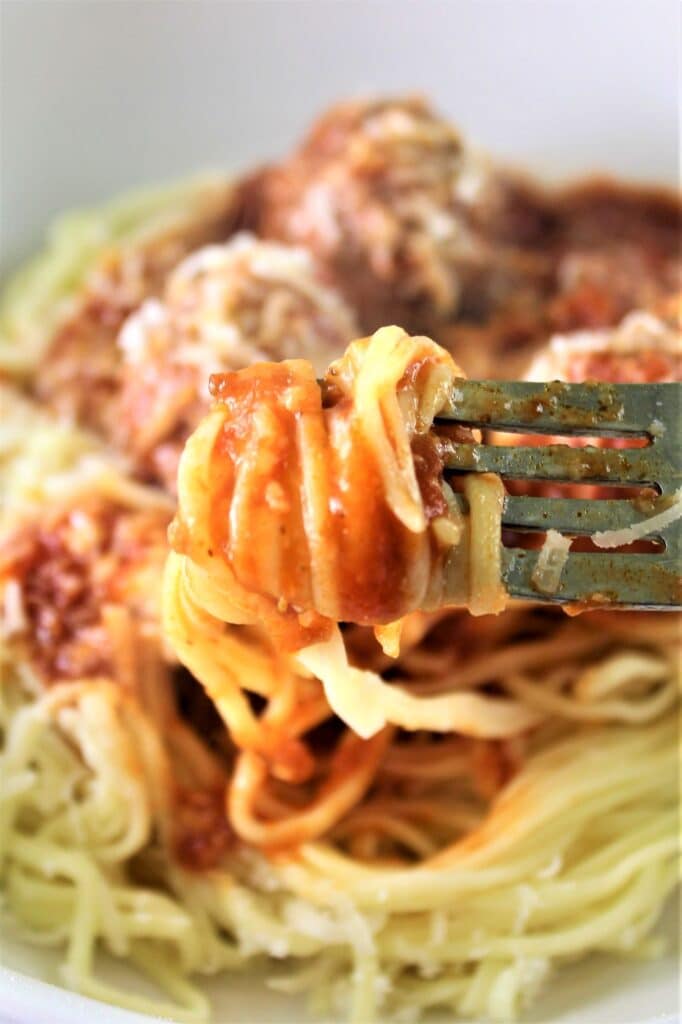
But if you happen to have a pasta machine, you can easily roll it through the sheeter and then into the cutter to cut those long noodles. For a while, I had this one (affiliate link) that you screw to the side of your counter and hand crank. I found it to be tedious and eventually bought this one (affiliate link) that attaches to a KitchenAid mixer (the one in my video--affiliate link) and never looked back.
Making Different Shapes
There are so many shapes of pasta out there, I wouldn't even begin to try to name them all! And I'm also no expert on how to make those shapes. But there is someone who is, and his name is Luca D'Onofrio. He is a pastaio, which is just a fancy name for an expert pasta maker.
I've watched this video of him making pasta on YouTube at least 20 times and every time it's just so mesmerizing. He makes it look so easy, and I've actually made bowties (farfalle) and a few other shapes through watching his video. I'll defer to him for teaching you how to do those, but most of them are pretty easy.
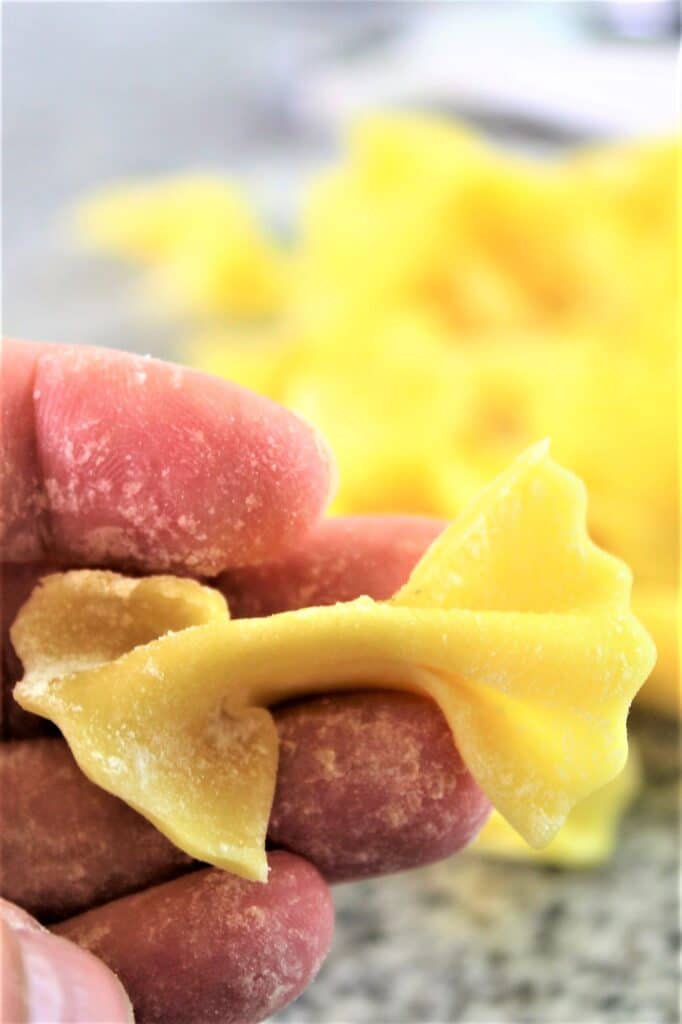
Storing Fresh Pasta
If you're serving your fresh pasta within a few hours of making it, simply sprinkle it with a little extra gluten free flour so it doesn't clump up or stick to itself. Cover it with plastic wrap and place it in the refrigerator until you're ready to boil and serve.
It can be held in the fridge for just a day or so if you're making it one day and serving it the next. But if you don't plan on eating it after a day, the best way to store it is in the freezer.
I like to put mine in a gallon ziptop plastic baggie in individual "nests" and press out as much air as possible before zipping. That way, if you only want a single serving of pasta you can easily remove one "nest" at a time (or a couple for two servings, etc).
Cooking Homemade Gluten Free Pasta
Homemade pasta cooks really fast, within about 3 minutes or so. I wouldn't go beyond that for al dente, but test a noodle for doneness before removing from the water.
I like to fill a measuring cup with some of the pasta cooking water before draining the pasta, just in case I need it to thicken the sauce I'm making. The water for gluten free pasta is always full of lots of starch, which makes it perfect for thickening sauces.
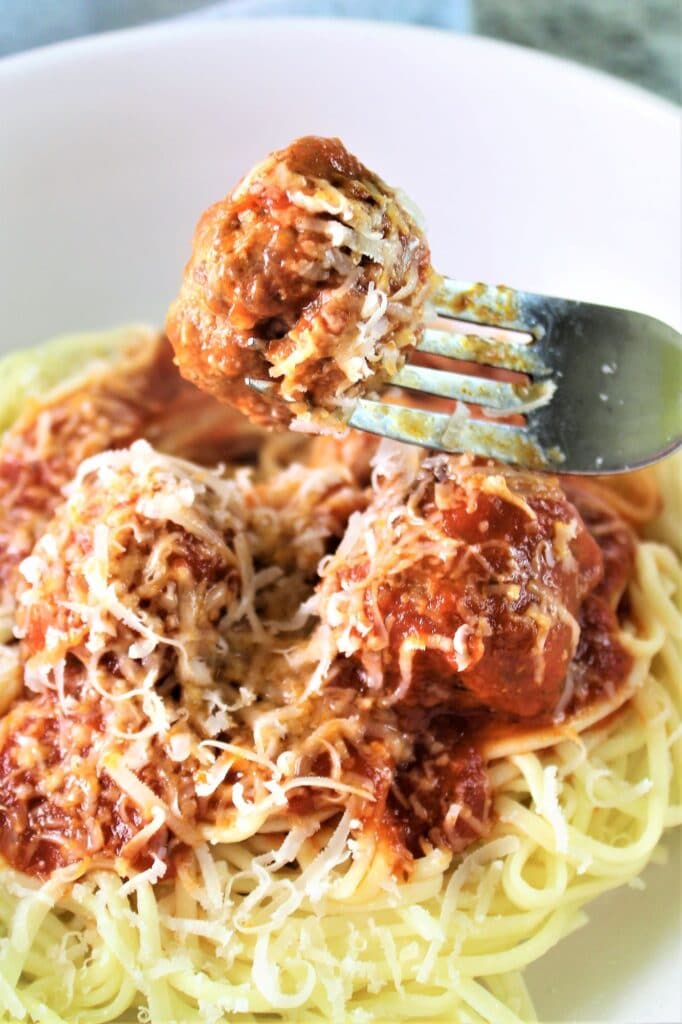
Sauces to Serve with My Homemade Pasta
I know it seems like extra work, but sometimes you just want the shapes of pasta you want, right? And fresh pasta BLOWS dried pasta out of the water. It's so easy, you may never go back to boxed pasta again! Think of the pastabilities (hello, cheese ravioli!)😜
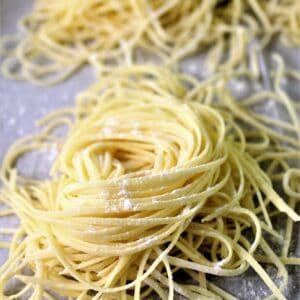
Homemade Gluten Free Pasta
Ingredients
- 2 cups (280 g) Kim's gluten free bread flour blend
- ¼ cup (30 g) tapioca starch
- 1 teaspoon kosher salt
- 2 large eggs
- 4 large egg yolks
- 1 tablespoon olive oil
- 2-4 tablespoon water
Instructions
- In the bowl of a food processor or in a large bowl, add flour, tapioca starch, and salt. Pulse to combine.
- Add eggs, egg yolks, and olive oil and pulse to combine. Slowly drizzle in water just until dough starts to come together on top of the blade. If mixing in bowl, add water until dough feels slightly tacky, not dry at all, but not really wet.
- Knead until smooth on flour surface and wrap in plastic wrap. Allow to sit for 30 minutes.
- Working with half the dough at a time, rewrap the other half in plastic wrap and set aside. Flatten the dough into about ¼-inch thick. Run it through a pasta sheeter 2-3 times on the 1st setting to smooth it out, folding it over itself before putting it back through. Turn the knob to the 2nd setting and run it through once, then the 3rd, 4th, and 5th, or to as thin as you'd like (I stop after one time on setting 5). Alternatively, roll the dough on a well-floured surface with a rolling pin to desired thin.
- Use the spaghetti cutter or fettuccine cutter to cut the dough. Alternatively, roll the dough into a log and cut with a knife to desired thickness.
- Cook the pasta in a large pot of salted water until al dente, about 3 minutes, depending on the size and thickness of your pasta.


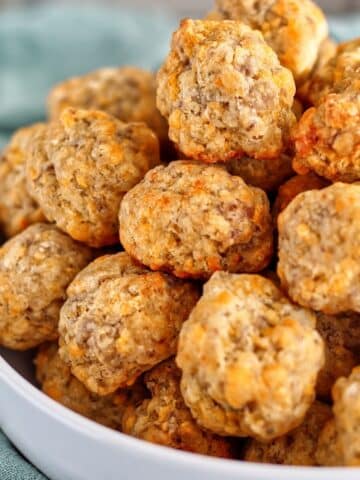
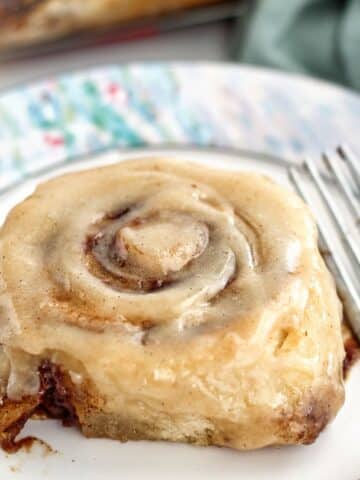

Dave
Kim, I made one batch of this dough for homemade ravioli. I'm a seasoned home cook, I make breads, pasta dough, and lots of things for many years. This is my first attempt at GF dough. I have to tell you I am thoroughly impressed. I could not tell the difference from using regular gluten flour. Also the dough was easy to work with and tastes delicious. I've made several of your recipes ( I have a family member that cannot have gluten) and none of them disappointed. Hats off to you young lady. Excellent work creating gluten free recipes. Now people who suffer from this can enjoy great dishes.
Kim
Awe, you are so sweet, Dave! Thank you so much for your kind words (especially the "young" lady, haha!) 🥰🥰🥰
Louise
Kim, you’ve done it again!! This recipe is amazing - just like all your others. I haven’t had a filled pasta since 2012 and I tried this recipe this week and made the most incredible ravioli.
I’m going make another couple of batches to freeze. Thank you.
Kim
So glad you liked it, Louise 🥰
TRA
Amazing noodles. Simple to make if you have a food processor. I rolled them out by hand and cut them thick like how my grandma used to make her soup noodles which are more like a flat dumpling than a noodle. My grandma passed away in 2013 and the last time I had her soup was probably 25 years ago. I have to admit that I teared up a little eating these.
Kim
Awe, this actually made me tear up just reading your comment. I'm humbled so much and appreciate your comment more than you can imagine.
Jessica Chase
This pasta tastes amazing and is a dream to work with in the pasta maker but I’m struggling to get it to not stick together while I’m rolling out the rest of the dough. . Even separating each individual piece of pasta and using lots of flour is not always a guarantee. I can do that with fettuccine but I can’t imagine trying to do that with spaghettini. I don’t have the dough too wet because I’m not having stickiness and rarely have to add any flour to the dough while rolling it out. I’ve made pasta a good number of times so I know what the dough should feel like and as I’ve said, I’ve had zero issues using my pasta maker. Any suggestions? I would like to make it more often but it takes a long time to separate each individual noodle. If I wasn’t having problems with the noodles sticking together it would definitely be a 5 stars plus recipe. It is as good or batter than any fresh gluten free pasta I had in Italy this past fall!
Kim
Oh no! I've never had that problem before. They've never stuck together. Sometimes it's just a matter of getting the exact right amount of water. Did you by chance substitute anything within the flour blend itself? If you want to tell me the brands of the components for the flour blend you used, I may be able to troubleshoot.
Zoe
Can I use all yolk? Can't eat egg white
Kim
You can try it. You'll probably need to increase the water content to account for no egg whites.
Michelle
I've made this recipe twice now, each time getting multiple dishes from it. It is absolutely fantastic. The noodles are stretchy with a really nice chew and bouncy spring to them. The first time I made these, I made the entire batch into spaghetti noodles, eating some right away and freezing the rest. When cooking from frozen, you need to cook them right away after removing from the freezer otherwise they'll clump into dough balls when defrosting. But they froze beautifully and cooked up perfectly from the frozen state.
The last batch I made, I rolled out some of the dough and just left the remainder unformed in the refrigerator. When I wanted pasta about a week later, it was just a quick roll through the pasta maker and boil. That worked out so well that I might just leave a batch permanently in the fridge so that I can make whatever pasta shape at a moment's notice.
Kim
I am SO thrilled you're enjoying this pasta!!! It really is a workhorse in the kitchen 🥰
Molly McDonald
I don't have a pasta roller or cutter. Can roll the pasta out with just a rolling pin and free cut it ?
Kim
Yes, you should be able to. It will take a lot of rolling, but it can be done.
Aaron
This is the best recipe for gluten free pasta I've yet found. Thanks Kim for doing all the legwork developing these recipes and sharing with us.
When I want to use my pasta extruder instead of rolling it out by hand, I reduce the water to 1/2 tablespoon and add 1 tsp psyllium husk powder to the recipe. This creates a drier dough with a more sand-like consistency which the extruder handles much better than the easier-to-roll out, albeit stickier original. I hope that helps some folks.
I also use the lasagna die on the extruder to create sheets to make tortellini or ravioli or whatever other hand-made shape I want.
Lori McCleery
This is fabulous! Store bought gluten free pasta is just... no, not good, not right, for us. I was cautiously optimistic about this recipe, purchased small quantities of the ingredients to make the bread flour, just in case. I am VERY pleased with the result. I make my own pasta (gluten) anyway so this wasn't anything new for me. Now I don't have to make two different kinds of pasta, we can all eat the gluten free. My son's diet has just expanded. Thank you, Kim!
Kim
Awe, yay!!! I'm so glad you liked it 🙂
Emmie Lyn
Have you tried dehydrating this pasta to keep at room temperature?
Kim
I have not. I don't have a dehydrator and I'm not sure with the eggs how that works.
Abbey
I made some ravioli with this pasta dough. As I was cutting the dough, it seemed to dry out and become quite hard even though I was trying to work quickly. I used a little bit of water to moisten the dough. After I cooked the raviolis, they were so hard. It was quite disappointing, it was my first time attempting a gluten free dough. But I don't think overworked the dough, I followed the recipe very closely. I am not sure why they were so tough??? I rolled them out pretty thin, it was an "average thickness". Any thoughts on how the dough was so tough??? I cooked them quite long too
Kim
It sounds like you just didn't add enough water. Make sure your dough is somewhat tacky when you take it out of the food processor (or bowl) as it states in the recipe. Also, did you use my flour blend? If you didn't, I can't help you with the texture.
Candice
I used your dough recipe to make homemade raviolis. The store bought ones tend to be really hard to find and they break up in the pan, falling apart soo easy. soo with my new attachment on my mixer I went to mak’in dough. My raviolis were firm and tasted great. Thanks for sharing. I can have raviolis again with homemade marinara. Oh ya! It’s a beautiful day!
Kim
That is awesome, Candice!! I actually have ravioli on my list of many things to make as a blog post because I miss ravioli, too 😍
Andreea
Hi, can I make this recipe vegan? How can I make it? Thanks a lot!
Kim
I don't think it would work, Andrea. Sorry!
Gillie
I used to make chicken and noodles, and miss eating it so much. Could these be cut and used like noodles?
Kim
I think they could, Gillie! I'm not sure if your recipe is anything like my mom's chicken and noodles, but I think this pasta would work great in her recipe so I'm hopeful it would in yours as well 🙂
Pam V
So excited to try this. I found an old pasta maker at the thrift store and its just been sitting and waiting for me to be adventurous enough to use it, and find a recipe for pasta. Thank you Kim!
Jackwelyn
Has this been tried with dehydrated cauliflower pulverized into flour. What portion would you recommend to substitute for a portion of the gf flour mix?
Kim
I honestly have no idea. I've never seen dehydrated cauliflower here. I wish I could be of more help about this, but I just don't know.